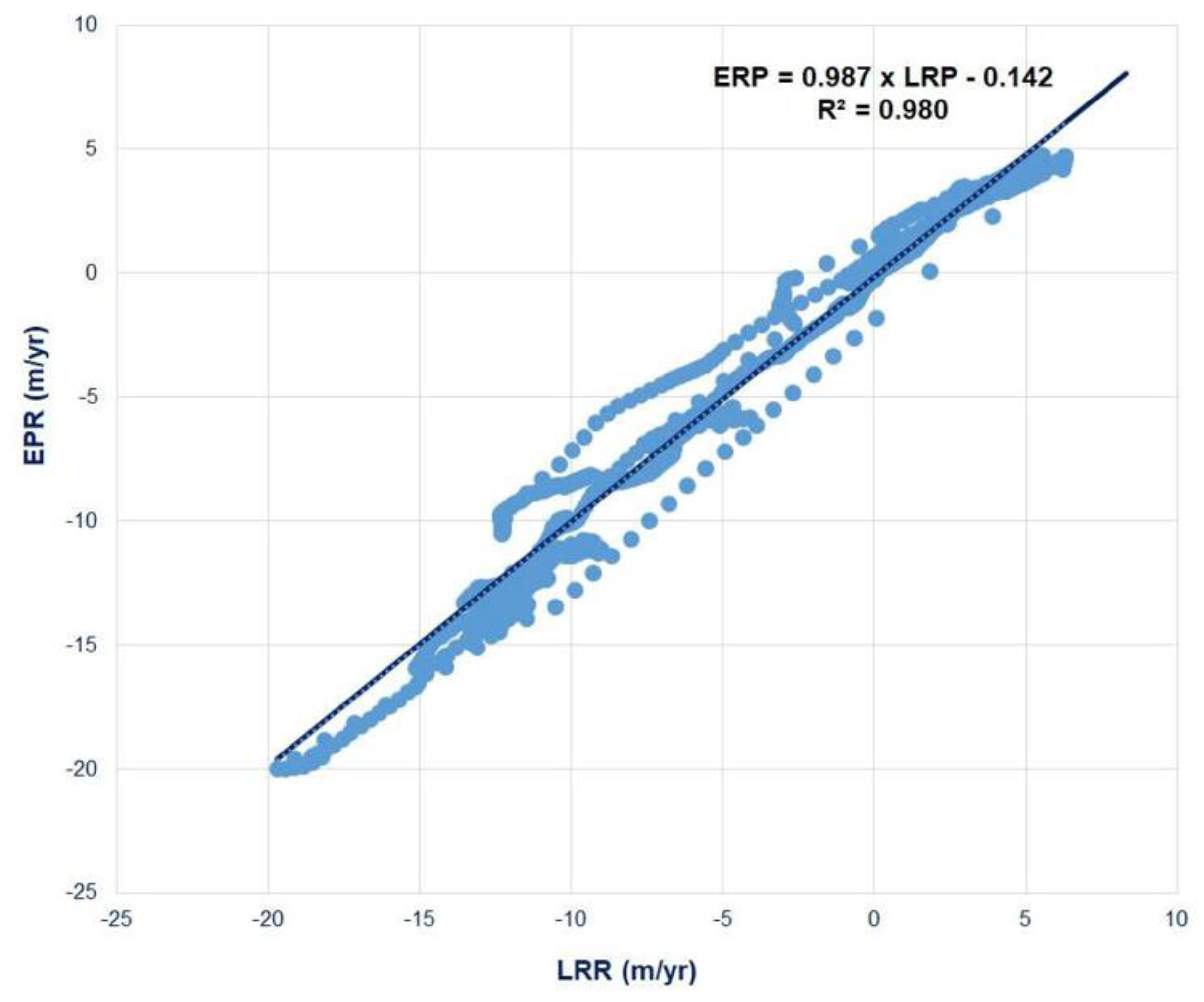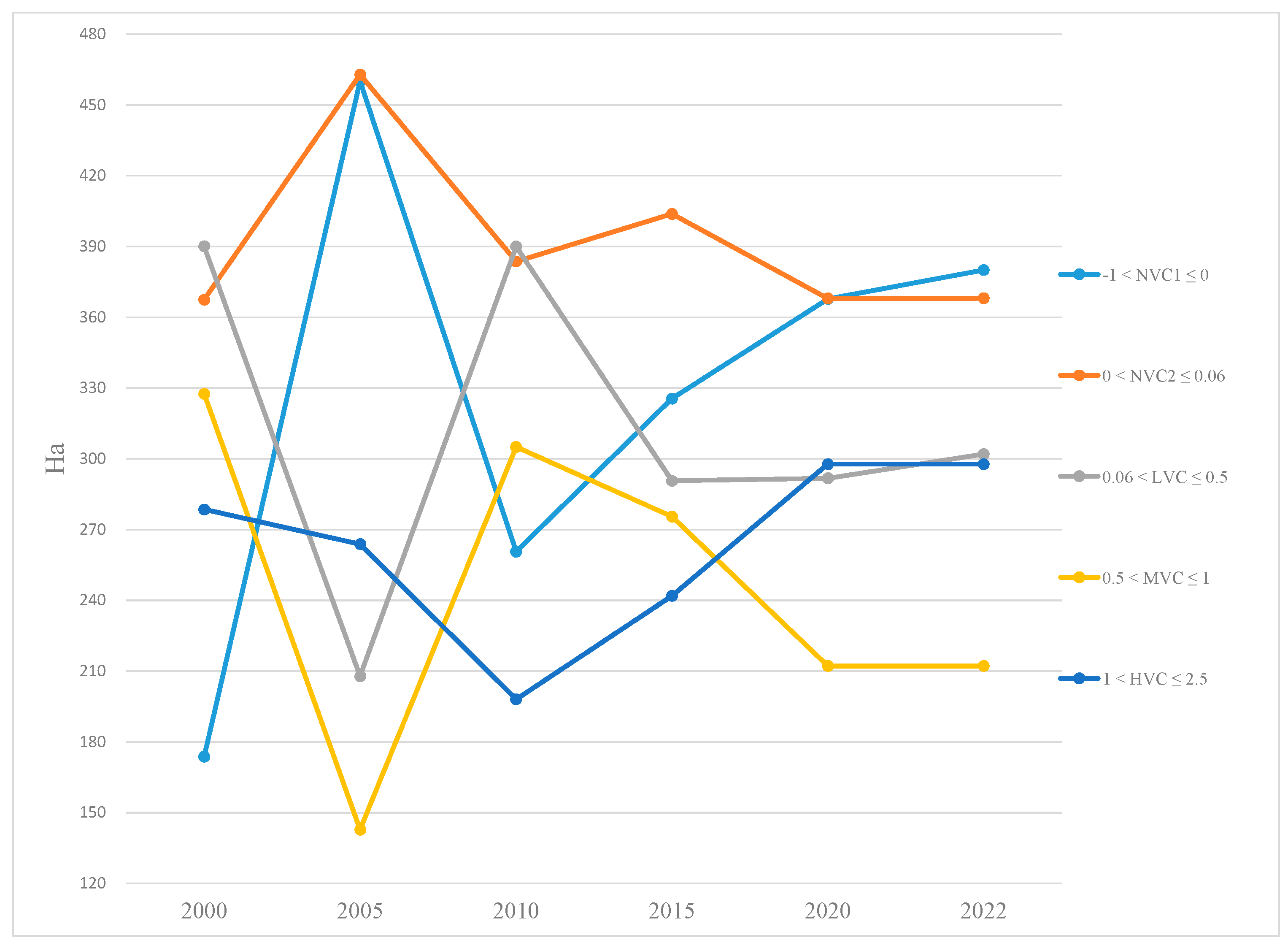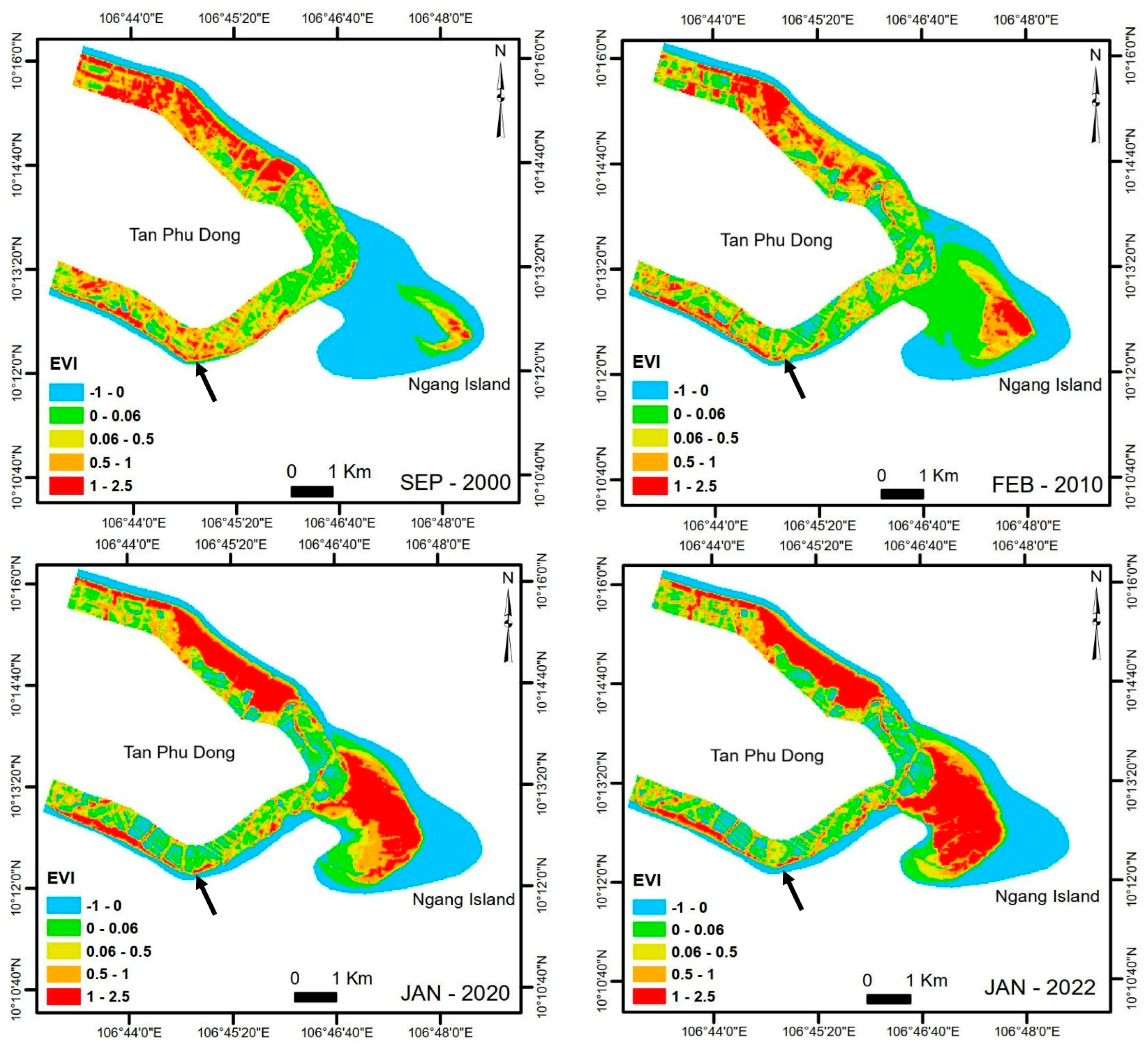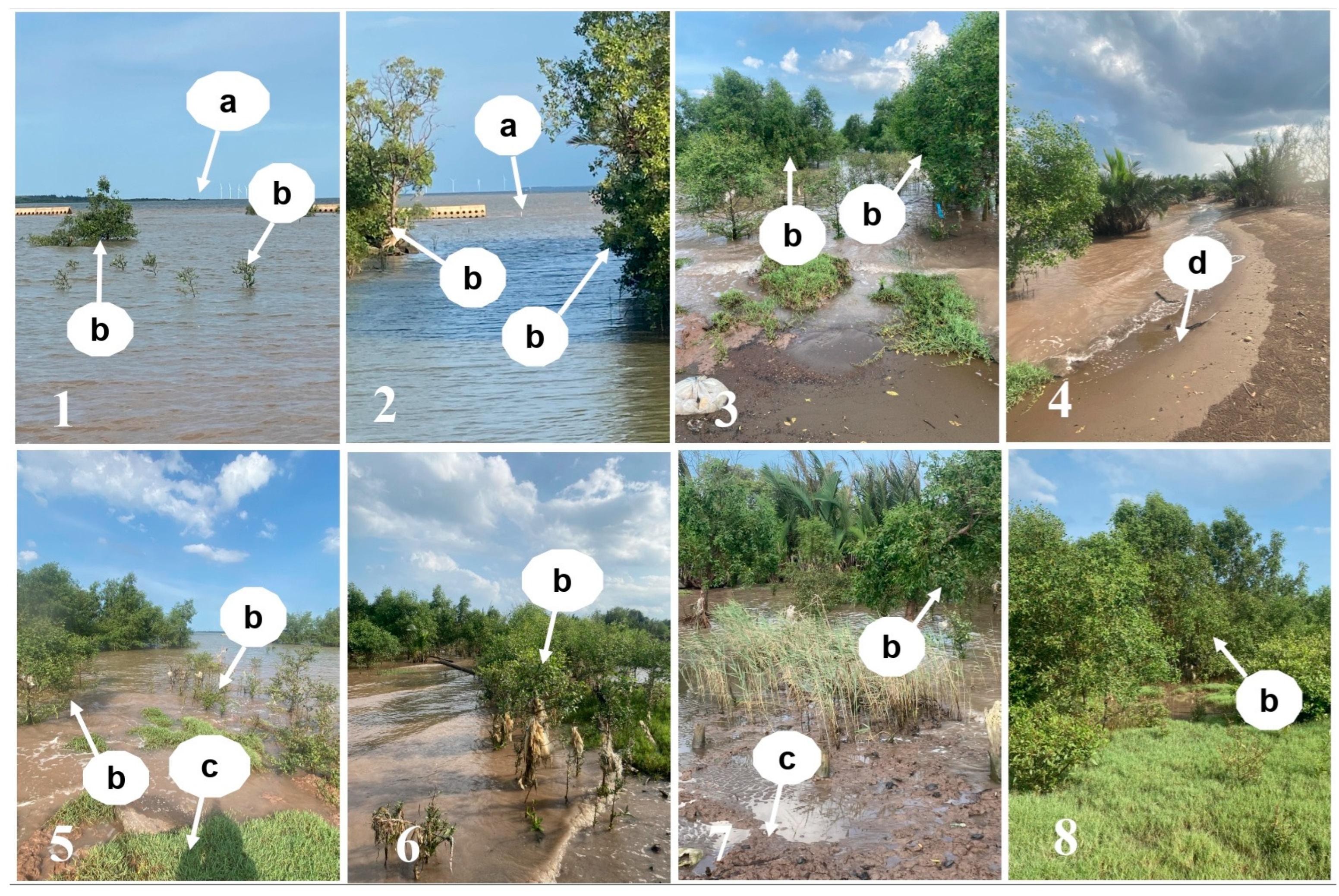Monitoring the Effectiveness of Emergent Detached Offshore Structures in Mangrove Vegetation Increase: Lessons and Recommendations
Abstract
1. Introduction
2. Materials and Methods
2.1. Site Description
2.2. Methods
- -
- Sr is the per year rate of shoreline change (m/year);
- -
- f0 is the distance between the baseline and shoreline at the oldest date of a particular transect (m);
- -
- fy is the distance between the baseline and shoreline on the most recent date on the same transect (m);
- -
- n is the total number of years from the oldest date to the most recent date.
- -
- L represents the distance of the shore position from the baseline (m);
- -
- t is the shoreline date interval (years);
- -
- a is the slope of the fitted line (m/year) (i.e., the shoreline change rate—LRR);
- -
- b is the y-intercept.
- -
- Sd is the shoreline change distance (m);
- -
- df is the distance between the baseline and farthest shoreline (m) at a particular transect;
- -
- dc is the distance between the baseline and closest shoreline (m) along the same transect.
- -
- Snm is net the movement of the shoreline (m);
- -
- f0 is the distance between the baseline and shoreline (m) on the oldest date of a particular transect;
- -
- fy is the distance between the baseline and shoreline (m) on the youngest date of the same transect.
3. Results
3.1. The Vegetation Cover Between 2000 and 2022
3.2. The Shoreline Change Between 2000 and 2022
3.3. The Mangrove Growth
4. Discussion
4.1. Tien Giang HTBs and Vegetation Cover Increase
4.2. Mangrove Growth Process
4.3. Tien Giang HTBs in Mangrove Protection
4.4. Limitations of This Study
5. Conclusions
Author Contributions
Funding
Institutional Review Board Statement
Informed Consent Statement
Data Availability Statement
Acknowledgments
Conflicts of Interest
References
- Cappietti, L. Converting Emergent Breakwaters into Submerged Breakwaters. J. Coast. Res. 2011, 64, 479–483. Available online: https://www.jstor.org/stable/26482218 (accessed on 29 December 2023).
- Sheng-Wen, T.; Cheng-Chung, C. A highly wave dissipation offshore breakwater. Ocean Eng. 2000, 27, 315–330. [Google Scholar] [CrossRef]
- Bacchiocchi, F.; Airoldi, L. Distribution and dynamics of epibiota on hard structures for coastal protection. Estuar. Coast. Shelf Sci. 2003, 56, 1157–1166. [Google Scholar] [CrossRef]
- Jackson, N.L.; Harley, M.D.; Armaroli, C.; Nordstrom, K. Beach morphologies induced by breakwaters with different orientations. Geomorphology 2015, 239, 48–57. [Google Scholar] [CrossRef]
- Becchi, C.; Ortolani, I.; Muir, A.; Cannicci, S. The effect of breakwaters on the structure of marine soft-bottom assemblages: A case study from a North-Western Mediterranean basin. Mar. Pollut. Bull. 2014, 87, 131–139. [Google Scholar] [CrossRef] [PubMed]
- Thomalla, F.; Vincent, C.E. Designing Offshore Breakwaters Using Empirical Relationships: A Case Study from Norfolk, United Kingdom. J. Coast. Res. 2004, 20, 1224–1230. Available online: https://www.jstor.org/stable/4299378 (accessed on 29 December 2023). [CrossRef]
- Pranzini, E.; Rossi, L.; Lami, G.; Jackson, N.I.; Norstrom, K.F. Reshaping beach morphology by modifying offshore breakwaters. Ocean Coast. Manag. 2018, 154, 168–177. [Google Scholar] [CrossRef]
- Birben, A.R.; Özölçer, I.H.; Karasu, S.; Kömürcü, M. Investigation of the effects of offshore breakwater parameters on sediment accumulation. Ocean. Eng. 2007, 34, 284–302. [Google Scholar] [CrossRef]
- Stanley, O.D.; Lewis, R.R., III. Strategies for mangrove rehabilitation in an eroded coastline of Selangor, peninsular Malaysia. J. Coast. Res. 2009, 12, 142–154. [Google Scholar]
- Hashim, R.; Kamali, B.; Tamin, N.M.; Zakaria, R. An integrated approach to coastal rehabilitation: Mangrove restoration in Sungai Haji Dorani, Malaysia. Estuar. Coast. Shelf Sci. 2010, 86, 118–124. [Google Scholar] [CrossRef]
- Mohamed Rashidi, A.H.; Jamal, M.H.; Hassan, H.Z.; Sendek, S.S.M.; Sopie, S.L.M.; Hamid, M.R.A. Coastal Structures as Beach Erosion Control and Sea Level Rise Adaptation in Malaysia: A Review. Water 2021, 13, 1741. [Google Scholar] [CrossRef]
- Tu, L.X.; Manh, L.H.; Ba, H.T.; Duong, D.V.; Vu, H.T.D.; Wright, D.; Bui, V.H.; Anh, D.T. Wave energy dissipation through a hollow triangle breakwater on the coastal Mekong Delta. Ocean. Eng. 2022, 245, 110419. [Google Scholar] [CrossRef]
- Tu, L.X.; Phong, N.C.; Thanh, V.Q.; Quan, T.Q.; Wright, D.P.; Anh, D.T. Multi-scale modelling for hydrodynamic and morphological changes of breakwater in coastal Mekong Delta in Vietnam. J. Coast. Conserv. 2022, 26, 18. [Google Scholar] [CrossRef]
- Akbar, A.A.; Sartohadi, J.; Djohan, T.S.; Rytohardoyo, S. The role of breakwaters on the rehabilitation of coastal and mangrove forests in West Kalimantan, Indonesia. Ocean Coast. Manag. 2017, 138, 50–59. [Google Scholar] [CrossRef]
- Luom, T.T.; Nguyen, T.P.; Anh, N.T.; Tung, N.T.; Tu, L.X.; Duong, T.A. Using Fine-Grained Sediment and Wave Attenuation as a New Measure for Evaluating the Efficacy of Offshore Breakwaters in Stabilizing an Eroded Muddy Coast: Insights from Ca Mau, the Mekong Delta of Vietnam. Sustainability 2021, 13, 4798. [Google Scholar] [CrossRef]
- Ministry of Agriculture; Rural Development of Vietnam (MARD). Coastal Mangrove Forests in the Mekong Delta Decreased in Area Over the Past 15 Years. 2017. Available online: http://vea.gov.vn/vn/quanlymt/baotondadangsh/tintuchoatdong/tintucvasukien/tintuc/Pages/Di%E1%BB%87n-t%C3%ADch-r%E1%BB%ABng-ng%E1%BA%ADp-m%E1%BA%B7n-%C4%90%E1%BB%93ng-b%E1%BA%B1ng-s%C3%B4ng-C%E1%BB%ADu-Long-gi%E1%BA%A3m-trong-5-n%C4%83m-qua.aspx (accessed on 12 December 2018).
- Vietnamese Prime Minister (VPM). Project on Prevention and Control of River Bank Erosion and Coastal Erosion Until 2030; VPM: Hanoi, Vietnam, 2020. [Google Scholar]
- Nguyen, T.P. Offshore structures, sea mud accumulation and mangrove regeneration: Insights from the Vietnamese Mekong Delta, Vietnam. Ocean. Coast. Manag. 2022, 225, 106243. [Google Scholar] [CrossRef]
- Tu, L.X.; Ba, T.H.; Thanh, V.Q.; Wright, D.P.; Tanim, A.H.; Anh, D.T. Evaluation of coastal protection strategies and proposing multiple lines of defense under climate change in the Mekong Delta for sustainable shoreline protection. Ocean. Coast. Manag. 2022, 228, 106301. [Google Scholar] [CrossRef]
- Tien Giang PPC. Decision No. 3441/QD-UBND Approving the Detailed Construction Masterplan for Con Ngang eco-Tourism Development Area (Scale 1/500) in Phu Tan Commune, Tan Phu Dong District; Tien Giang PPC: My Tho, Vietnam, 2009. [Google Scholar]
- Carlson, T.N.; Ripley, D.A. On the relation between NDVI, fractional vegetation cover, and Leaf Area Index. Remote Sens. Environ. 1997, 62, 241–252. [Google Scholar] [CrossRef]
- Huete, A.; Didan, K.; Miura, T.; Rodriguez, E.P.; Gao, X.; Ferreira, L.G. Overview of the radiometric and biophysical performance of the MODIS vegetation indices. Remote Sens. Environ. 2002, 83, 195–213. [Google Scholar] [CrossRef]
- Moore, L.J. Shoreline mapping techniques. J. Coast. Res. 2000, 16, 111–124. Available online: https://www.jstor.org/stable/4300016 (accessed on 29 December 2023).
- Genz, A.S.; Fletcher, C.H.; Dunn, R.A.; Frazer, L.N.; Rooney, J.J. The predictive accuracy of shoreline change rate methods and alongshore beach variation on Maui, Hawaii. J. Coast. Res. 2007, 231, 87–105. [Google Scholar] [CrossRef]
- Nguyen, T.P.; Nguyen, Q.H.; Sang, T.V. Shoreline Change and Community-based Climate Change Adaptation: Lessons Learnt from Brebes Regency, Indonesia. Ocean. Coast. Manag. 2022, 218, 106037. [Google Scholar] [CrossRef]
- Pimple, U.; Simonetti, D.; Peters, R.; Berger, U.; Podest, E.; Gond, V. Enhancing monitoring of mangrove spatiotemporal tree diversity and distribution patterns. Land Degrad. Dev. 2022, 34, 1265–1282. [Google Scholar] [CrossRef]
- Thompson, W.D.; Walter, S.D. A reappraisal of the Kappa Coeficient. J. Clin. Epidemiol. 1988, 41, 949–958. [Google Scholar] [CrossRef]
- Alberg, A.J.; Park, J.W.; Hager, B.W.; Brock, M.V.; Diener-West, M. The use of ‘Overall Accuracy’ to evaluate the validity of screening or diagnostic tests. J. Gen. Intern. Med. 2004, 19, 460–465. [Google Scholar] [CrossRef] [PubMed]
- Bheeroo, R.A.; Chandrasekar, N.; Kaliraj, S.; Magesh, N.S. Shoreline change rate and erosion risk assessment along the Trou Aux Biches–Mont Choisy beach on the northwest coast of Mauritius using GIS-DSAS technique. Environ. Earth Sci. 2016, 75, 444. [Google Scholar] [CrossRef]
- Burningham, H.; French, J. Understanding coastal change using shoreline trend analysis supported by cluster-based segmentation. Geomorphology 2017, 282, 131–149. [Google Scholar] [CrossRef]
- Nassar, K.; Mahmod, W.E.; Fath, H.; Masria, A.; Nadaoka, K.; Negm, A. Shoreline change detection using DSAS technique: Case of North Sinai coast, Egypt. Mar. Georesour. Geotechnol. 2019, 37, 81–95. [Google Scholar] [CrossRef]
- Nguyen, Q.H.; Takewaka, S. Land subsidence and its effects on coastal erosion in the Nam Dinh Coast (Vietnam). Cont. Shelf Res. 2020, 207, 104227. [Google Scholar] [CrossRef]
- Nguyen, T.P.; Thuan, N.B.; Loi, L.T.; Quoc, H.V. Morphological Evolution of an Intertidal Mudflat in Relation to Mangrove Growth: Implications for Future Erosion Control. Life 2024, 14, 711. [Google Scholar] [CrossRef]
- Duke, N.C. Australia’s Mangroves—The Authoritative Guide to Australia’s Mangrove Plants; University of Queensland: Queensland, Australia, 2006. [Google Scholar]
- Nguyen, T.P.; Luom, T.T.; Parnell, K.E. Mangrove transplantation in Brebes Regency, Indonesia: Lessons and Recommendations. Ocean. Coast. Manag. 2017, 149, 12–21. [Google Scholar] [CrossRef]
- Li, X.; Liu, J.P.; Saito, Y.; Nguyen, V.L. Recent evolution of the Mekong Delta and the impacts of dams. Earth-Sci. Rev. 2017, 175, 1–17. [Google Scholar] [CrossRef]
- Liu, Z.; Fagherazzi, S.; Cui, B. Success of coastal wetlands restoration is driven by sediment availability. Nat. Commun. Earth Environ. 2021, 2, 44. [Google Scholar] [CrossRef]
- Phan, H.M. Coastal and Seasonal Hydrodynamics and Morphodynamics of the Mekong Delta. Ph.D. Thesis, Delft University of Technology, Delft, The Netherlands, 2020. [Google Scholar] [CrossRef]
- Thanh, V.Q.; Reyns, J.; Wackerman, C.; Eidam, E.F.; Roelvink, D. Modelling suspended sediment dynamics on the subaqueous delta of the Mekong River. Cont. Shelf Res. 2017, 147, 213–230. [Google Scholar] [CrossRef]
- Kamali, B.; Hashim, R. Mangrove restoration without planting. Ecol. Eng. 2011, 37, 387–391. [Google Scholar] [CrossRef]
- Nguyen, T.P.; Parnell, K.E. Gradual expansion of mangrove areas as an ecological solution for stabilizing a severely eroded mangrove dominated muddy coast. Ecol. Eng. 2017, 107, 239–243. [Google Scholar] [CrossRef]
- VPM. Program to Upgrading and Reinforcing the Sea dyke System from Quang Ngai to Kien Giang Provinces; VPM: Hanoi, Vietnam, 2009. [Google Scholar]
- VPM. Resolution on Sustainable Socio-Economic Development for Adaptation to Climate Change; VPM: Hanoi, Vietnam, 2017. [Google Scholar]
- VPM. Resolution on Socio-Economic Development Orientation, National Defence and Security in the Mekong Delta of Vietnam Until 2030 with a Vision up to 2045; VPM: Hanoi, Vietnam, 2022. [Google Scholar]
- Tien, H.V.; Anh, N.T.; Nguyen, T.P.; Nhut, M.L.M. Ecological Engineering and Restoration of Eroded Muddy Coasts in South East Asia: Knowledge Gaps and Recommendations. Sustainability 2021, 13, 1248. [Google Scholar] [CrossRef]
- Minh, N.N.; Duong, D.V.; Tu, L.D.; San, D.C.; Truong, P.N.; Quyen, N.; Bang, T.; Wright, D.P.; Tamin, A.H.; Anh, D.T. Wave reduction efficiency for three classes of breakwaters on the coastal Mekong Delta. Appl. Ocean Res. 2022, 129, 103362. [Google Scholar] [CrossRef]
- San, D.C.; Duong, N.B.; Phong, N.C.; Tu, L.X.; Damien, P.V.B.; Guillou, S.; Dan, N.K. Numerical Study on Measures for Protecting the Go-Cong Coastlines (Vietnam) from Erosion. Water 2022, 14, 3850. [Google Scholar] [CrossRef]
- Winterwerp, J.C.; Borst, W.G.; De Vries, M.B. Pilot study on the erosion and rehabilitation of a mangrove mud coast. J. Coast. Res. 2005, 21, 223–230. [Google Scholar] [CrossRef]
- Winterwerp, J.C.; Erftemeijer, P.L.A.; Suryadiputra, N.; Van Eijk, P.; Zhang, L. Defining Eco-Morphodynamic Requirements for Rehabilitating Eroding Mangrove-Mud Coasts. Wetlands 2013, 33, 515–526. [Google Scholar] [CrossRef]






| Year | Path | Row | Acquisition Date | Satellite Image | Cloud Cover | Cloud Cover Land | Spatial Resolution (m) |
|---|---|---|---|---|---|---|---|
| 2000 | 125 | 053 | 27 September 2000 | Landsat-5 (TM) | 15 | 13 | 30 |
| 2005 | 125 | 053 | 13 February 2005 | Landsat-5 (TM) | 12 | 12 | |
| 2010 | 125 | 053 | 27 February 2010 | Landsat-5 (TM) | 20 | 23 | |
| 2015 | 125 | 053 | 9 February 2015 | Landsat-8 (OLI) | 2.86 | 3.37 | |
| 2020 | 125 | 053 | 6 January 2020 | Landsat-8 (OLI) | 2.28 | 2.18 | |
| 2022 | 125 | 053 | 11 January 2022 | Landsat-8 (OLI) | 1.43 | 2.43 |
| Section | Type | GPS Coordinates | Length (m) | |
|---|---|---|---|---|
| Start Point | End Point | |||
| 0 | 10°12′17.48″ N; 106°45′11.48″ E | 10°12′16.22″ N; 106°45′13.63″ E | 79 | |
| 1B | HTB—Type A | 10°12′16.23″ N; 106°45′13.84″ E | 10°12′18.59″ N; 106°45′17.20″ E | 127 |
| 2B | 10°12′18.87″ N; 106°45′17.82″ E | 10°12′21.38″ N; 106°45′21.48″ E | 136 | |
| 3B | 10°12′21.74″ N; 106°45′22.04″ E | 10°12′24.24″ N; 106°45′25.73″ E | 135 | |
| 4C | HTB—Type B | 10°12′24.60″ N; 106°45′26.37″ E | 10°12′26.99″ N; 106°45′30.00″ E | 135 |
| 5C | 10°12′27.37″ N; 106°45′30.56″ E | 10°12′29.81″ N; 106°45′34.29″ E | 135 | |
| 6C | 10°12′30.17″ N; 106°45′34.80″ E | 10°12′32.57″ N; 106°45′38.45″ E | 135 | |
| 7C | 10°12′32.94″ N; 106°45′39.00″ E | 10°12′35.40″ N; 106°45′42.78″ E | 135 | |
| 8C | 10°12′35.79″ N; 106°45′43.32″ E | 10°12′37.96″ N; 106°45′47.05″ E | 135 | |
| 9C | 10°12′38.27″ N; 106°45′47.71″ E | 10°12′39.64″ N; 106°45′51.79″ E | 135 | |
| 10C | 10°12′39.92″ N; 106°45′52.47″ E | 10°12′41.34″ N; 106°45′56.59″ E | 135 | |
| No. | Levels of Vegetation Cover | EVI Values |
|---|---|---|
| 1 | Non-vegetation cover—Intertidal mudflats—NVC 1 | −1 < EVI ≤ 0 |
| 2 | Non-vegetation cover—Barren lands—NVC 2 | 0 < EVI ≤ 0.06 |
| 3 | Low vegetation cover—LVC | 0.06 < EVI ≤ 0.5 |
| 4 | Medium vegetation cover—MVC | 0.5 < EVI ≤ 1 |
| 5 | High vegetation cover—HVC | 1 < EVI ≤ 2.5 |
| Monitoring Sites | ||||
|---|---|---|---|---|
| Location | Mangrove Forest | Seasonal Inundation | Sediment Accumulation | Remarks |
| The Monitoring Sites Behind the HTBs | ||||
| 1 | • | • | • | Bruguiera mature trees grew in clusters in seasonally inundated areas with fine-grained sediment |
| 2 | • | • | • | Bruguiera mature trees grew in clusters in seasonally inundated areas with fine-grained sediment |
| 3 | • | • | • | Bruguiera mature trees grew in clusters in seasonally inundated areas with fine-grained sediment |
| 4 | • | • | • | Bruguiera mature trees grew in clusters in seasonally inundated areas with fine-grained sediment |
| The monitoring sites outside HTBs | ||||
| 5 | • | • | • |
|
| 6 | • | • | • |
|
Disclaimer/Publisher’s Note: The statements, opinions and data contained in all publications are solely those of the individual author(s) and contributor(s) and not of MDPI and/or the editor(s). MDPI and/or the editor(s) disclaim responsibility for any injury to people or property resulting from any ideas, methods, instructions or products referred to in the content. |
© 2025 by the authors. Licensee MDPI, Basel, Switzerland. This article is an open access article distributed under the terms and conditions of the Creative Commons Attribution (CC BY) license (https://creativecommons.org/licenses/by/4.0/).
Share and Cite
Phong, N.T.; Thuan, N.B.; Tien, N.N. Monitoring the Effectiveness of Emergent Detached Offshore Structures in Mangrove Vegetation Increase: Lessons and Recommendations. Life 2025, 15, 136. https://doi.org/10.3390/life15020136
Phong NT, Thuan NB, Tien NN. Monitoring the Effectiveness of Emergent Detached Offshore Structures in Mangrove Vegetation Increase: Lessons and Recommendations. Life. 2025; 15(2):136. https://doi.org/10.3390/life15020136
Chicago/Turabian StylePhong, Nguyen Tan, Nguyen Bao Thuan, and Nguyen Ngoc Tien. 2025. "Monitoring the Effectiveness of Emergent Detached Offshore Structures in Mangrove Vegetation Increase: Lessons and Recommendations" Life 15, no. 2: 136. https://doi.org/10.3390/life15020136
APA StylePhong, N. T., Thuan, N. B., & Tien, N. N. (2025). Monitoring the Effectiveness of Emergent Detached Offshore Structures in Mangrove Vegetation Increase: Lessons and Recommendations. Life, 15(2), 136. https://doi.org/10.3390/life15020136








